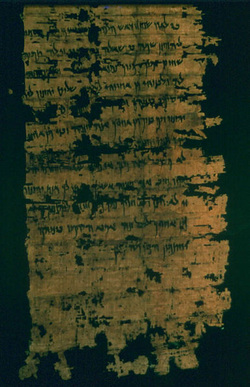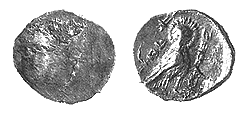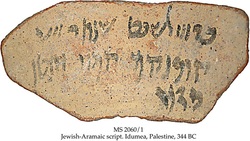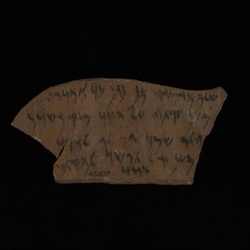Biblical Studies Seminar, Term 2, 2021-22
All meetings of the seminar will be at 5pm on MS Teams
9 February—Harald Samuel (Oxford), ‘Late or Non-Standard Hebrew? Synchronic Diversity in Hellenistic Hebrew’
https://teams.microsoft.com/l/meetup-join/19%3ameeting_NDcxYmZlMzgtY2IzYy00MTE5LTk5NWQtZGI3YjY4ZjkzMjBi%40thread.v2/0?context=%7b%22Tid%22%3a%228370cf14-16f3-4c16-b83c-724071654356%22%2c%22Oid%22%3a%22b4ec9400-315a-4887-bf1e-632a841b04cc%22%7d
2 March—Ekatarina Kozlova (London), ‘2 Samuel and A “Topography” of Violence in David’s Rule’
https://teams.microsoft.com/l/meetup-join/19%3ameeting_MmMxOGI3NTktZGM3ZC00ZDZlLTllOGUtZjIwYzM1N2FlODhh%40thread.v2/0?context=%7b%22Tid%22%3a%228370cf14-16f3-4c16-b83c-724071654356%22%2c%22Oid%22%3a%22b4ec9400-315a-4887-bf1e-632a841b04cc%22%7d
9 March—Sean Adams (Glasgow), ‘Negotiating Genre: Jewish Genre Practices in the Hellenistic Era’
https://teams.microsoft.com/l/meetup-join/19%3ameeting_ZjIwZWM2ZmYtMDEzNS00ZWYwLThlMDUtYTA0ZDA4YzQ5OWE0%40thread.v2/0?context=%7b%22Tid%22%3a%228370cf14-16f3-4c16-b83c-724071654356%22%2c%22Oid%22%3a%22b4ec9400-315a-4887-bf1e-632a841b04cc%22%7d
16 March—Ola Wikander (Lund and Cambridge), ‘El(ohim) says: May he live!—Northwest Semitic Poetics and Egyptian Influences in the Biblical Story of Joseph’
https://teams.microsoft.com/l/meetup-join/19%3ameeting_OWU3MzJlMWUtYTViNy00NTM5LWJlNDgtNzhkY2Q4ZGMxMGM3%40thread.v2/0?context=%7b%22Tid%22%3a%228370cf14-16f3-4c16-b83c-724071654356%22%2c%22Oid%22%3a%22b4ec9400-315a-4887-bf1e-632a841b04cc%22%7d
All meetings of the seminar will be at 5pm on MS Teams
9 February—Harald Samuel (Oxford), ‘Late or Non-Standard Hebrew? Synchronic Diversity in Hellenistic Hebrew’
https://teams.microsoft.com/l/meetup-join/19%3ameeting_NDcxYmZlMzgtY2IzYy00MTE5LTk5NWQtZGI3YjY4ZjkzMjBi%40thread.v2/0?context=%7b%22Tid%22%3a%228370cf14-16f3-4c16-b83c-724071654356%22%2c%22Oid%22%3a%22b4ec9400-315a-4887-bf1e-632a841b04cc%22%7d
2 March—Ekatarina Kozlova (London), ‘2 Samuel and A “Topography” of Violence in David’s Rule’
https://teams.microsoft.com/l/meetup-join/19%3ameeting_MmMxOGI3NTktZGM3ZC00ZDZlLTllOGUtZjIwYzM1N2FlODhh%40thread.v2/0?context=%7b%22Tid%22%3a%228370cf14-16f3-4c16-b83c-724071654356%22%2c%22Oid%22%3a%22b4ec9400-315a-4887-bf1e-632a841b04cc%22%7d
9 March—Sean Adams (Glasgow), ‘Negotiating Genre: Jewish Genre Practices in the Hellenistic Era’
https://teams.microsoft.com/l/meetup-join/19%3ameeting_ZjIwZWM2ZmYtMDEzNS00ZWYwLThlMDUtYTA0ZDA4YzQ5OWE0%40thread.v2/0?context=%7b%22Tid%22%3a%228370cf14-16f3-4c16-b83c-724071654356%22%2c%22Oid%22%3a%22b4ec9400-315a-4887-bf1e-632a841b04cc%22%7d
16 March—Ola Wikander (Lund and Cambridge), ‘El(ohim) says: May he live!—Northwest Semitic Poetics and Egyptian Influences in the Biblical Story of Joseph’
https://teams.microsoft.com/l/meetup-join/19%3ameeting_OWU3MzJlMWUtYTViNy00NTM5LWJlNDgtNzhkY2Q4ZGMxMGM3%40thread.v2/0?context=%7b%22Tid%22%3a%228370cf14-16f3-4c16-b83c-724071654356%22%2c%22Oid%22%3a%22b4ec9400-315a-4887-bf1e-632a841b04cc%22%7d
| biblical_studies_seminar_spring_2022.pdf |





 RSS Feed
RSS Feed
